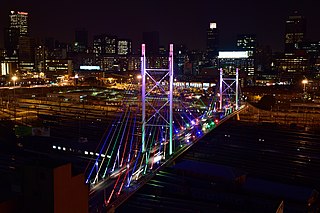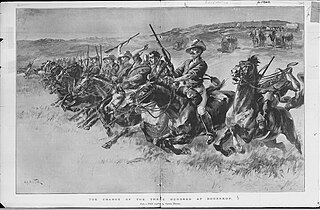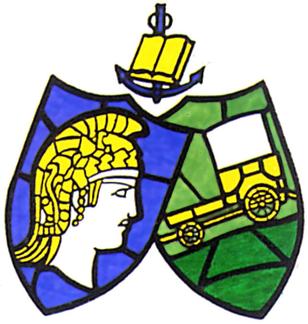Related Research Articles

Johannesburg is the most populous city in South Africa with 4,803,262 people, and is classified as a megacity; it is one of the 100 largest urban areas in the world. It is the provincial capital of Gauteng, the wealthiest province in South Africa. Johannesburg is the seat of the Constitutional Court, the highest court in South Africa. Most of the major South African companies and banks have their head offices in Johannesburg. The city is located within the mineral-rich Witwatersrand hills, the epicentre of the international-scale mineral, gold and (specifically) diamond trade.

The Jameson Raid was a botched raid against the South African Republic carried out by British colonial administrator Leander Starr Jameson, under the employment of Cecil Rhodes. It involved 500 British South Africa Company police launched from Rhodesia over the New Year weekend of 1895–96. Paul Kruger, for whom Rhodes had great personal hatred, was president of the South African Republic at the time. The raid was intended to trigger an uprising by the primarily British expatriate workers in the Transvaal but it failed.

The University of the Witwatersrand, Johannesburg, commonly known as Wits University or Wits, is a multi-campus public research university situated in the northern areas of central Johannesburg, South Africa. The university has its roots in the mining industry, as do Johannesburg and the Witwatersrand in general. Founded in 1896 as the South African School of Mines in Kimberley, it is the third oldest South African university in continuous operation.

Johannesburg is a large city in Gauteng Province of South Africa. It was established as a small village controlled by a Health Committee in 1886 with the discovery of an outcrop of a gold reef on the farm Langlaagte. The population of the city grew rapidly, becoming a municipality in 1898. In 1928 it became a city making Johannesburg the largest city in South Africa. In 2002 it joined ten other municipalities to form the City of Johannesburg Metropolitan Municipality. Today, it is a centre for learning and entertainment for all of South Africa. It is also the capital city of Gauteng.
Frederik van Zyl Slabbert GCOB was a South African political analyst, businessman and politician. He is best known for having been the leader of the official opposition – the Progressive Federal Party (PFP) – in the House of Assembly from 1979 to 1986.

Melville is a bohemian suburb of Johannesburg, Gauteng, South Africa. It is the location of many restaurants and taverns, which are mostly frequented by students from the nearby University of Johannesburg, located in Auckland Park, and the University of the Witwatersrand, located in Braamfontein. It is one of the city's most popular tourist destinations. The suburb is to the west of the Johannesburg CBD. It is located in Region B of the City of Johannesburg Metropolitan Municipality.
Heriotdale is a suburb of Johannesburg, South Africa. The suburb lying south of Malvern and north of Rosherville, is an industrial area. It is located in Region F of the City of Johannesburg Metropolitan Municipality.
Chrisville is a suburb of Johannesburg, South Africa. It is located in Region F of the City of Johannesburg Metropolitan Municipality. A large part of the suburb is currently taken up by a mine dump.
Judith's Paarl is a suburb of Johannesburg, South Africa. It is a small suburb found on the eastern edge of the Johannesburg central business district (CBD), tucked between the suburbs of Lorentzville and Bezuidenhout Valley, with Troyeville and Kensington to the south. It is located in Region F of the City of Johannesburg Metropolitan Municipality.
Lorentzville is a suburb of Johannesburg, South Africa. It is a small suburb found on the eastern edge of the Johannesburg central business district (CBD), tucked between the suburbs of Bertrams and Judith's Paarl, with Troyeville to the south. It is located in Region F of the City of Johannesburg Metropolitan Municipality.

Transvaal University College was a multi-campus public research university in South Africa which gave rise to the University of the Witwatersrand and the University of Pretoria.

The Seed is Mine: The Life of Kas Maine, a South African Sharecropper 1894-1985 is a microhistorical study by Charles van Onselen. It is a profound social history of an African peasant sharecropper and his family in a racially divided South Africa. Van Onselen paints a stark picture of the relationship between landowner and farmer and its development in an increasingly racist society.
The South African Republic Police was the police force of the former country, South African Republic, one of two Internationally recognized Boer countries of the mid 19th to early 20th century. The Boers often called the South African Republic by its acronym ZAR while in the English-speaking world the republic was generally known as the Transvaal. Members of the police force were known as ZARPs. After the Union of South Africa was established in 1910, the force was incorporated into the South African Police Force.
Umkhosi Wezintaba, 'Umkosi we Seneneem', 'Abas'etsheni', the 'Nongoloza' and the 'Ninevites' were simultaneously criminal gangs and resistance movements formed by African men in South Africa between 1890 and 1920.

Raymond Suttner is a South African activist, academic, journalist and public figure.

Simmer and Jack Mines Ltd is a South African company which was founded in 1887 by the German August Simmer and Scotsman John Jack, shortly thereafter selling the majority shareholding to Gold Fields of South Africa Ltd. The company was listed until 2013 at the Johannesburg Stock Exchange.
Parlshoop is a suburb of Johannesburg, South Africa, around 4 km west of City Hall. It borders Langlaagte to the north and Homestead Park to the northeast. The name comes from the village of Paarlshoop, the oldest private township on the Witwatersrand.
Belinda Bozzoli was a South African author, academic, sociologist, and politician. She was deputy vice-chancellor of the University of the Witwatersrand for a period from 2002, having headed its school of social sciences. In 2014 Bozzoli was elected a member of the South African parliament for the Democratic Alliance. From 2019 she served as Shadow Minister of Higher Education, Science and Technology.
Gareth van Onselen is a South African political strategist, pollster, and commentator. A former head of communications for the opposition Democratic Alliance, he resigned from the party acrimoniously in 2013. He currently runs Victory Research, a market research company. Until May 2023, he also wrote a regular column in the Business Day.
References
- ↑ "CURRICULUM VITAE" (PDF). University of Pretoria.
- 1 2 3 "Prof Charles van Onselen". University of Pretoria . 2022. Retrieved 9 June 2022.
- ↑ "UP's Prof Charles van Onselen awarded prestigious Academy of Science of South Africa Humanities Book Prize". University of Pretoria . 15 March 2021. Retrieved 9 June 2022.
- ↑ "Bozzoli, Belinda". www.encyclopedia.com. Archived from the original on 7 December 2020. Retrieved 5 December 2020.
- ↑ "Footnotes".
- ↑ Grimes, William (3 October 2007). "Charles van Onselen - The Fox and the Flies: The Secret Life of a Grotesque Master Criminal - Book - Review" . The New York Times. ISSN 0362-4331 . Retrieved 31 July 2019.